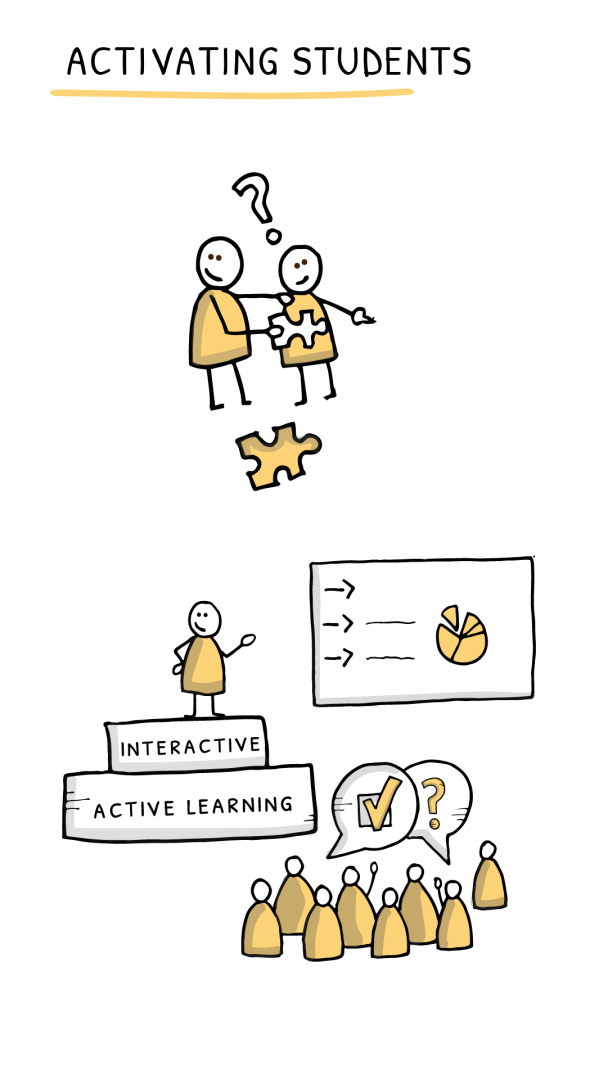Student-Activating Teaching Methodologies
Learning is a verb and a social activity. This means students should engage intensely with the course material and with each other, making mistakes and learning from those mistakes. In short, it is time to make sure the right people are engaged.
Why?
Learning and studying is anything but a passive activity. The goal of student-activating teaching methodologies is for students to make active use of new knowledge. In this way, they learn better, more thoroughly and more lastingly, as well as acquiring additional academic and other skills that will help them excel and solve problems in the future. Student-activating teaching methodologies encourage students to think for themselves, to stop and to consider problems and thereby to improve their problem-solving skills. Your lectures also become more interesting and stimulating for yourself, as you have more contact with your students, which is crucial (especially for online lectures).
What?
Learning in-depth and truly understanding the course material works best if students feel a personal connection with the theme, can understand why it is relevant, can apply it to their own situation and can make active use of the information. Student-activating teaching methodologies can be employed in the various phases of the learning process:
1. Activating prior knowledge
- Before the meeting (asynchronous)
- Ask students to take a picture or to find an article or a social media post about the theme and to submit it in Brightspace.
- Ask students to do an online quiz to find out what they already know.
- During the meeting (synchronous)
- Pique students’ interest in and curiosity about the theme at the start of the session. Use a controversial statement, a real-world example, a recent news item…
- Discuss the preparation using a poll with statements on the basis of students’ answers.
- Gather students’ prior knowledge about the theme through an online or offline brainstorm. This also gives you a good sense of where your students stand.
2. Acquiring new knowledge and skills
- Asynchronous
- Show a knowledge clip with questions and assignments to students.
- Assign processing assignments in Brightspace in connection with an article, podcast or video.
- During a meeting (synchronous)
- If your group is too large to involve everyone in interactive discussions use the snowballing method: give students a problem to solve and some time to reflect individually and write down a solution. Have them compare their answers in twos or threes; then form groups of four or six. One student of each group reports to the entire class what the group has discussed. Give clear instructions and times.
- Use the same quiz or assignment at the start (or during preparations) and at the end of the lecture. This immediately gives students the feedback that they have learned something new.
3. Processing knowledge (cognitive)
- Before the meeting (asynchronous)
- Let students work together in an online discussion forum (such as Brightspace or MS Teams) to deepen their knowledge on the basis of statements.
- Assign the role of moderator to a student. This student also forwards any questions left unanswered to the lecturer.
- Let students come up with interim examination questions about the theme, including key words for the assessment.
- Let students work together to create a mind map of the information in the module (e.g. using Miro or MS Whiteboard).
- During a meeting (synchronous)
- Let students describe the main concepts in their own words in a quiz with open questions. Create a word cloud (in Wooclap, for instance) for anonymous sharing of answers.
- Share frequently encountered misconceptions with students and ask them to explain to each other in pairs why these are misconceptions.
4. Applying acquired knowledge and skills
- Before the meeting (asynchronous)
- Let students form pairs, film their new skill and give each other feedback.
- Let students do assignments individually and then provide peer feedback using the assessment rubric for the module.
- When a student has submitted an assignment, provide elaborated examples so they can check their own work.
- During an online or offline meeting (synchronous)
- Give a demonstration or practical example during the meeting to demonstrate the complexity of professional practice. Let students apply their new knowledge to come up with a solution to the practical problem or to elaborate an assignment.
- In seminars, practical labs and workshops, students can work on practical assignments or simulations to practise their new knowledge and skills. Let students use the rubric in groups to help each other and provide peer feedback.
5. Reflecting upon the learning process
- Before the meeting (asynchronous)
- Let students use finished assignments to represent their learning process visually in a compilation.
- Let students interview someone from the professional field and describe how they see themselves compared to this example.
- During an online or offline meeting (synchronous)
- Give a practical example and poll students on how competent they feel compared to this example. Ask a number of students to explain how they would act, and ask a number of students to respond in case of any doubts.
- Have students discuss their learning process in groups (breakout rooms). Each student provides feedback to their fellow student on what is going well and what needs improving. Use a rubric or the module’s assessment criteria for this.
How?
Make sure you have a good grasp of the teaching methodologies. You could test them on a few colleagues. Do you use a digital tool? Do not assume students will self-evidently be able to or want to use it. Use AUAS tools where possible, as the university has vetted their security and privacy aspects.
- Wooclap is suitable for live quizzes or polls.
- Padlet or Miro is the tool to use for online or offline brainstorming during a lecture or as preparation.
- In MS Teams, you can use forms and polls during an online meeting or as preparation.
- Use Brightspace for discussion forums, assignments or the recording of quizzes.
Under Tips, you will find websites with examples of student-activating teaching methodologies. Note that some examples list tools that are not in use at AUAS.

